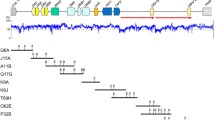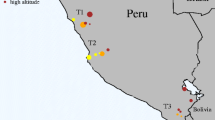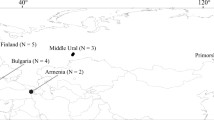Abstract
Hawaiian honeycreepers (Drepanidinae) have evolved in the absence of mosquitoes for over five million years. Through human activity, mosquitoes were introduced to the Hawaiian archipelago less than 200 years ago. Mosquito-vectored diseases such as avian malaria caused by Plasmodium relictum and Avipoxviruses have greatly impacted these vulnerable species. Susceptibility to these diseases is variable among and within species. Due to their function in adaptive immunity, the role of major histocompatibility complex genes (Mhc) in disease susceptibility is under investigation. In this study, we evaluate gene organization and levels of diversity of Mhc class II β chain genes (exon 2) in a captive-reared family of Hawaii ‘amakihi (Hemignathus virens). A total of 233 sequences (173 bp) were obtained by PCR+1 amplification and cloning, and 5720 sequences were generated by Roche 454 pyrosequencing. We report a total of 17 alleles originating from a minimum of 14 distinct loci. We detected three linkage groups that appear to represent three distinct haplotypes. Phylogenetic analysis revealed one variable cluster resembling classical Mhc sequences (DAB) and one highly conserved, low variability cluster resembling non-classical Mhc sequences (DBB). High net evolutionary divergence values between DAB and DBB resemble that seen between chicken BLB system and YLB system genes. High amino acid identity among non-classical alleles from 12 species of passerines (DBB) and four species of Galliformes (YLB) was found, suggesting that these non-classical passerine sequences may be related to the Galliforme YLB sequences.


Similar content being viewed by others
References
Afanassieff M, Goto RM, Ha J, Sherman M, Zhong L, Auffray C, Coudert F, Zoorob R, Miller MM (2001) At least one class I gene in restriction fragment pattern-Y (Rfp-Y), the second MHC gene cluster in the chicken, is transcribed, polymorphic and shows divergent specialization in antigen binding region. J Immunol 166:3324–3333
Aguilar A, Smith TB, Wayne RB (2005) A comparison of variation between a MHC pseudogene and microsatellite loci of the little greenbul (Andropadus virens). BMC Evol Biol 5:47–53
Aguilar A, Edwards SV, Smith TB, Wayne RK (2006) Patterns of variation in MHC class II b loci of the little greenbul (Andropadus virens) with comments on MHC evolution in birds. J Hered 97(2):133–142
Atkinson CT, Saili KS, Utzurrum RB, Jarvi SI (2014) Experimental evidence for evolved tolerance to avian malaria in a wild population of low elevation Hawai’i ‘amakihi (Hemignathus virens). Ecohealth 10:366–375
Atkinson C, Dusek R, Woods K, Iko W (2000) Pathogenicity of avian malaria in experimentally-infected Hawaii ‘amakihi. J Wildlife Dis 36:197–204
Balakrishnan CN, Ekblom R, Völker M, Westerdahl H, Godinez R, Kotkiewicz H, Burt DW, Graves T, Griffin DK, Warren WC, Edwards SV (2010) Gene duplication and fragmentation in the zebra finch major histocompatibility complex. BMC Biol 8:29–47
Banko WE, Banko PC (2009) Historic decline and extinction. In: Pratt TK, Atkinson CT, Banko PC, Jacobi JD, Woodworth BL (eds) Conserv Biol of Hawaii Birds: Implications for Island Avifauna. Yale University Press, New Haven, pp 25–58
Bollmer JL, Dunn PO, Whittingham LA, Wimpee C (2010) Extensive MHC class II B gene duplication in a passerine, the common yellowthroat (Geothlypis trichas). J Hered 101(4):448–460
Bonneaud C, Sorci G, Morin V, Westerdahl H, Zoorob R, Wittzell H (2004) Diversity of MHC class I and IIB genes in house sparrows (Passer domesticus). Immunogenetics 55:855–865
Boonyanuwat K, Thummabutra S, Sookmanee N, Vatchavalkhu V, Siripholvat V (2005) Direct submission. Animal Husbandry Division, Department of Livestock Development, Ministry of Agriculture and Coorperative, Rachathevi, Bangkok, Bangkok, Thailand, p 10400
Borg A, Pedersen SA, Jensen H, Westerdahl H (2011) Variation in MHC genotypes in two populations of house sparrow (Passer domesticus) with different population histories. Ecol Evol 1(2):145–159
Borriello F, Krauter KS (1990) Reactive site polymorphism in the murine protease inhibitor gene family is delineated using a modification of the PCR reaction (PCR + 1). Nucleic Acids Res 18(18):5481–5487
Bourlet Y, Behar G, Guillemot F, Frechin N, Billault A, Chausse AM, Zoorob R, Auffray C (1988) Isolation of chicken major histocompatibility complex class II (B-L) beta chain sequences: comparison with mammalian beta chains and expression in lymphoid organs. EMBO J 7(4):1031–1039
Briles WE, McGibbon WH (1948) Heterozygosity of inbred lines of chickens as two loci affecting cellular antigens. Genetics 33:605
Briles WE, McGibbon WH, Irwan MR (1950) On multiple alleles affecting cellular antigens in the chicken. Genetics 35:633–652
Briles WE, Briles RW, Irwin MR (1952) Differences in specificity of the antigenic products of a series of alleles in the chicken. Genetics 37:359–368
Briles WE, Goto RM, Auffray C, Miller MM (1993) A polymorphic system related to but independent of the chicken major histocompatibility complex. Immunogenetics 15:449–59
Brown JH, Jardetzky T, Saper MA, Samraoui B, Bjorkman PJ, Wiley DC (1993) Three-dimensional structure of the human class II histocompatibility antigen HLA-DR1. Nature 364:33–39
Canal D, Alcaide M, Anmarkrud JA, Potti J (2010) Towards the simplification of MHC typing protocols: targeting classical MHC class II genes in a passerine, the pied flycatcher Ficedula hypoleuca. BMC Res Notes 3:236–246
Chen F, Pan L, Chao W, Dai Y, Yu W (2012) Character of chicken polymorphic major histocompatibility complex class II alleles of 3 Chinese local breeds. Poult Sci 91(5):1097–1104
Delany M, Robinson C, Goto R, Miller MM (2009) Architecture and organization of chicken microchromosome 16: order of the NOR, MHC-Y, and MHC-B subregions. J Hered 100:507–514
Edgar RC, Haas BJ, Clemente JC, Quince C, Knight R (2011) UCHIME improves sensitivity and speed of chimera detection. Bioinformatics 16:2194–2200
Edwards SV, Gasper J, Garrigan D, Martindale D, Koop BF (2000) A 39-kb sequence around a blackbird Mhc class II gene: ghost of selection past and songbird genome architecture. Mol Biol Evol 17(9):1384–1395
Freeman-Gallant CR, Johnson EM, Saponara F, Stanger M (2002) Variation at the major histocompatibility complex in Savannah sparrows. Mol Ecol 11:1125–1130
Galan M, Guivier E, Caraux G, Charbonnel N, Cosson JF (2010) A 454 multiplex sequencing method for rapid and reliable genotyping of highly polymorphic genes in large-scale studies. BMC Genomics 11:296–310
Gonzalez-Quevedo C, Phillips KP, Spurgin LG, Richardson DS (2015) 454 screening of individual MHC variation in an endemic island passerine. Immunogenetics 67:149–162
Guillemot F, Billault A, Pourquie O et al (1988) A molecular map of chicken MHC complex: the class II beta genes are closely linked to the class I genes and nucleolar organizer. EMBO J 7:2775–2785
Hardy DE (1960) Insects of Hawaii. Diptera: Nematocera-Brachycera. University of Hawaii Press, Honolulu
Hess CM, Gasper J, Hoekstra HE, Hill CE, Edwards CV (2000) MHC class II pseudogene and genomic signature of a 32-kb cosmid in the house finch (Carpodacus mexicanus). Genome Res 10(5):613–23
Hughes CR, Miles S, Walbrochl JM (2008) Support for the minimal essential MHC hypothesis: a parrot with a single, highly polymorphic MHC class II B gene. Immunogenetics 60:219–231
Hunt HD, Goto RM, Foster DN, Bacon LD, Miller MM (2006) At least one YMHCI molecule in the chicken is alloimmunogenic and dynamically expressed on spleen cells during development. Immunogenetics 58:297–307
Jacob JP, Milne S, Beck S, Kaufman J (2000) The major and a minor class II beta-chain (B-LB) gene flank the Tapasin gene in the B-F/B-L region of the chicken major histocompatibility complex. Immunogenetics 51(2):138–147
James HF, Olson SL (1991) Descriptions of thirty-two new species of birds from the Hawaiian Islands. Part II. Passeriformes. Ornithol Monogr 46:1–88
Jarvi SI, Briles WE (1992) Identification of the major histocompatibility complex in the ring-necked pheasant. Anim Genet 23:141–150
Jarvi S, Atkinson C, Fleischer R (2001) Immunogenetics and resistance to avian malaria in Hawaiian honeycreepers (Drepanidinae). Stud Avian Biol 22:254–263
Jarvi S, Farias MEM (2006) Molecular sexing and sources of CHD1-Z/W sequence variation in Hawaiian birds. Mol Ecol Notes 6:1003–1005
Jarvi SI, Tarr CL, McIntosh CE, Atkinson CT, Fleischer RC (2004) Natural selection of the major histocompatibility complex (Mhc) in Hawaiian honeycreepers (Drepanidinae). Mol Ecol 13:2157–2168
Jarvi SI, Herold UK, Farias ME, Atkinson CT (2013) Cryptic mtDNA diversity of Plasmodium relictum in the Hawaiian Islands. Parasitology 140(14):1741–50
Kaufman J (1999) Co-evolving genes in MHC haplotypes: the “rule” for nonmammalian vertebrates? Immunogenetics 50:228–236
Kaufman J, Jacob J, Shaw I, Walker B, Milne S, Beck S, Salomonsen J (1999) Gene organisation determines evolution of function in the chicken MHC. Immunol Rev 167:101–117
Klein J, Bontrop RE, Dawkins RL, Erlich HA, Gyllensten UB, Heise ER, Jones PP, Parham P, Wakeland EK, Watkins DI (1990) Nomenclature for the major histocompatibility complexes of different species: a proposal. Immunogenetics 31:217–219
Kropshofer H, Vogt AB, Moldenhauer G, Hammer J, Blum JS, Hämmerling GJ (1996) Editing of the HLA-DR peptide repertoire by HLA-DM. EMBO J 15:6144–6154
Lerner HRL, Meyer M, James HF, Hofreiter M, Fleischer RC (2011) Multilocus resolution of phylogeny and timescale in the extant adaptive radiation of Hawaiian honeycreepers. Curr Biol 21:1–7
LePage KT, Miller MM, Briles WE, Taylor RL (2000) Y genotype affects the fate of Rous sarcomas in B-2 B-5 chickens. Immunogenetics 51:751–754
Longeri M, Zanotti M, Damiani G (2002) Recombinant DRB sequences produced by mismatch repair of heteroduplexes during cloning in Escherichia coli. Eur J Immunogenet 29:517–523
Margulies M, Egholm M, Altman WE, Attiya S, Bader JS et al (2005) Genome sequencing in microfabricated high density picolitre reactors. Nature 437:376–380
Miller HC, Lambert DM (2004a) Gene duplication and gene conversion in class II MHC genes of New Zealand robins (Petroicidae). Immunogenetics 56(3):178–191
Miller HC, Lambert DM (2004b) Genetic drift outweighs balancing selection in shaping post-bottleneck major histocompatibility complex variation in New Zealand robins (Petroicidae). Mol Ecol 13:3709–3721
Miller MM, Goto BA, Zoorob R, Auffray C, Bumstead N, Briles WE (1994) Two Mhc class I and two Mhc class II genes map to the chicken Y system outside the B complex. Proc Natl Acad Sci U S A 91:4397–4401
Miller MM, Goto RM, Taylor RL Jr, Zoorob R, Auffray C, Briles RW, Briles WE, Bloom SE (1996) Assignment of Rfp-Y to the chicken major histocompatibility complex/NOR microchromosome and evidence for high-frequency recombination associated with the nucleolar organizer region. Proc Natl Acad Sci U S A 93(9):3958–3962
Miller MM, Robinson CM, Abernathy J, Goto RM, Hamilton MK, Zhou H, Delany ME (2014) Mapping genes to chicken microchromosome 16 and discovery of olfactory and scavenger receptor genes near the major histocompatibility complex. J Hered 105(2):203–215
Naruse TK, Kawata H, Inoko H, Isshiki G, Yamano K, Hino M, Tatsumi N (2002) The HLA-DOB gene displays limited polymorphism with only one amino acid substitution. Tissue Antigens 59:512–519
Niemiec PK, Read LR, Sharif S (2006) Synthesis of chicken major histocompatibility complex class II oligomers using a baculovirus expression system. Protein Expr Purif 46(2):390–400
Pharr GT, Gwynn AV, Bacon LD (1996) Histocompatibility antigen(s) linked to Rfp-Y (Mhc-like) genes in the chicken. Immunogenetics 45:52–58
Richardson DS, Westerdahl H (2003) MHC diversity in two Acrocephalus species: the outbred great reed warbler and the inbred Seychelles warbler. Mol Ecol 12:3523–3529
Schierman LW, Nordskog AW (1961) Relationship of blood type to histocompatibility in chickens. Science 134:1008–1009
Schmieder R, Lim YW, Rohwer F, Edwards R (2010) TagCleaner: identification and removal of tag sequences from genomic and metagenomic datasets. BMC Bioinformatics 11:341
Schmieder R, Edwards R (2011) Quality control and preprocessing of metagenomic datasets. Bioinformatics 27:863–864
Sepil I, Moghadam HK, Huchard E, Sheldon BC (2012) Characterization and 454 pyrosequencing of major histocompatibility complex class I genes in the great tit reveal complexity in a passerine system. BMC Evol Biol 12:68–86
Strand T, Westerdahl H, Ho¨glund J, Alatalo R, Siitari H (2007) The Mhc class II of the black grouse (Tetrao tetrix) consists of low numbers of B and Y genes with variable diversity and expression. Immunogenetics 59:725–734
Tamura K, Peterson D, Peterson N, Stecher G, Nei M, Kumar S (2011) MEGA5: molecular evolutionary genetics analysis using maximum likelihood, evolutionary distance, and maximum parsimony methods. Mol Biol Evol 28:2731–2739
Thoraval P, Afanassieff M, Bouret D, Luneau G, Esnault E, Goto RM, Am C, Zoorob R, Soubieux D, Miller MM, Dambrine G (2003) Role of nonclassical class I genes of the chicken major histocompatibility complex Rfp-Y locus in transplantation immunity. Immunogenetics 55:647–651
Vincek V, O’Huigin C, Satta Y, Takahata N, Boag PT, Grant PR, Grant BR, Klein J (1997) How large was the founding population of Darwin’s finches? Proc R Soc Lond B 264:111–118
Warren WC, Clayton DF, Ellegren H, Arnold AP, Hillier LW et al (2010) The genome of a songbird. Nature 464(7289):757–762
Westerdahl H, Wittzell H, von Schantz T (2000) MHC diversity in two passerine birds: no evidence for a minimal essential MHC. Immunogenetics 52:92–100
Wittzell H, Bernot A, Auffray C, Zoorob R (1999) Concerted evolution of two MHC class II B loci in pheasants and domestic chickens. Mol Biol Evol 16:479–490
Woodworth BL, Atkinson CT, LaPointe DA, Hart PJ, Spiegel CS, Tweed EJ, Henneman C, LeBrun J, Denette T, DeMots R, Kozar KL, Triglia D, Lease D, Gregor A, Smith T, Duffy D (2005) Host population persistence in the face of introduced vector-borne diseases: Hawaii ‘amakihi and avian malaria. Proc Natl Acad Sci U S A 102:1531–1536
Xu R, Li K, Chen G, Xu H, Qiang B, Li C, Liu B (2007) Characterization of genetic polymorphism of novel MHC B-LB II alleles in Chinese indigenous chickens. J Genet Genomics 34(2):109–118
Xu YX, Pitcovski J, Peterson L, Auffray C, Bourlet Y, Gerndt BM, Nordskog AW, Lamont SJ, Warner CM (1989) Isolation and characterization of three class II MHC genomic clones from the chicken. J Immunol 142(6):2122–2132
Zagalska-Neubauer M, Babik W, Stuglik M, Gustafsson L, Cichoń M, Radwan J (2010) 454 sequencing reveals extreme complexity of the class II major histocompatibility complex in the collared flycatcher. BMC Evol Biol 10:395–409
Zoorob R, Bernot A, Renoir DM, Choukri F, Auffray C (1993) Chicken major histocompatibility complex class II β genes: analyses of interallelic and interlocus sequence variance. Eur J Immunol 23:1139–45
Further reading
Hosomichi K, Shiina T, Shimizu S, Inoko H, Hanzawa K (2004) Characterization of Mhc class II B genes expressed in the chicken and quail immunological organs. (Direct submission)
Sharma D, Singh A, Gupta J, Kumar S, Nehra S (2006) Sequence analysis of BL Beta II for estimating genetic diversity among poultry species. (Direct submission)
Acknowledgments
This research was funded by Introduced Avian Diseases in Hawaii: Threats to Biodiversity of Native Forest Ecosystems, NSF DEB 0083944. Additional funding and support was provided by NIH/NCRR IDeA Networks of Biomedical Research Excellence (INBRE) P20RR016467, the National Institute of General Medical Sciences, National Institutes of Health, award number: P20GM 103466, NIG-NIGMS P30GM114737 and the Daniel K. Inouye College of Pharmacy, University of Hawaii at Hilo. We would like to thank Scott Derrickson for providing blood samples from the captive-reared ‘amakihi and Robert Fleischer for providing additional aliquots of DNA and for his helpful discussions.
Author information
Authors and Affiliations
Corresponding author
Additional information
This article is dedicated to the memory of Professor Elwood Briles in recognition for his monumental role in avian immunogenetics starting with his early discovery of alloantigen systems through to his recent contributions to genomic-based definitions of polymorphic regions within avian genomes.
Electronic supplementary material
Below is the link to the electronic supplementary material.
Online Resource 1
(PDF 119 kb)
Online Resource 2
(PDF 89 kb)
Online Resource 3
(PDF 335 kb)
Online Resource4
(PDF 215 kb)
Rights and permissions
About this article
Cite this article
Jarvi, S.I., Bianchi, K.R., Farias, M.E. et al. Characterization of class II β chain major histocompatibility complex genes in a family of Hawaiian honeycreepers: ‘amakihi (Hemignathus virens). Immunogenetics 68, 461–475 (2016). https://doi.org/10.1007/s00251-016-0908-z
Received:
Accepted:
Published:
Issue Date:
DOI: https://doi.org/10.1007/s00251-016-0908-z




